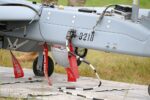The United States Marine Corps (USMC) and the Japanese Self-Defense Forces (JSDF) have reportedly integrated two key expeditionary defense systems—NMESIS (Navy/Marine Corps Expeditionary Ship Interdiction System) and MADIS (Marine Air Defense Integrated System)—during recent joint operations near Taiwan. The deployment signals a significant evolution in allied interoperability aimed at deterring Chinese maritime and aerial threats in the First Island Chain.
NMESIS Deployment Highlights Anti-Ship Focus
NMESIS is a land-based anti-ship missile system developed by the USMC to counter naval threats within contested littoral environments. It leverages the proven Kongsberg-Raytheon Naval Strike Missile (NSM), mounted on an unmanned Joint Light Tactical Vehicle (JLTV)-based launcher platform called the Remotely Operated Ground Unit for Expeditionary Fires (ROGUE-Fires).
According to recent reporting from Japanese defense observers and corroborated by open-source satellite imagery analysis, elements of NMESIS were deployed to Okinawa Prefecture during bilateral exercises conducted in mid-2025. The system’s presence was confirmed during the Iron Fist 2025 drills—a long-running US-Japan amphibious training series that has increasingly emphasized high-end conflict scenarios involving island seizure and denial operations.
The NSM provides precision strike capability out to approximately 185 km (100 nautical miles), with advanced sea-skimming flight profiles and terminal maneuverability designed to evade shipboard defenses. Its integration into EABO (Expeditionary Advanced Base Operations) doctrine supports distributed maritime denial across chokepoints such as the Miyako Strait—a key corridor for Chinese PLAN vessels transiting between the East China Sea and Pacific Ocean.
MADIS Enhances SHORAD Coverage Against Aerial Threats
Complementing NMESIS is the deployment of MADIS—a short-range air defense system optimized for countering UAVs, cruise missiles, rotary-wing aircraft, and low-flying fixed-wing threats. Built on JLTV platforms similar to NMESIS ROGUE-Fires units, MADIS comprises radar sensors (such as G/ATOR or X-band AESA), EO/IR tracking systems, electronic warfare modules for drone disruption, and kinetic interceptors including Stinger missiles or 30 mm cannons.
During Iron Fist 2025 exercises on Amami Ōshima Island—strategically located between Okinawa and Kyushu—MADIS units were observed operating alongside Japanese Type 03 medium-range SAM batteries. This co-deployment suggests an emergent layered air defense construct blending US SHORAD capabilities with JSDF medium-to-long-range assets.
Notably, MADIS has undergone accelerated fielding schedules following its combat validation against Iranian drones during Red Sea operations in late 2023. Its inclusion in Indo-Pacific exercises reflects growing concern over China’s expanding UAV fleet—including swarming loitering munitions—and cruise missile arsenals capable of saturating forward-deployed forces.
Interoperability Milestone Reflects Shift Toward Integrated Deterrence
The joint operation marks one of the first documented cases of active integration between USMC expeditionary fires systems and JSDF air/missile defense elements within operational proximity to Taiwan. While previous bilateral drills focused on logistics or humanitarian coordination, Iron Fist 2025 emphasized combined kill chains across domains—particularly maritime strike targeting via shared ISR feeds.
- C4ISR Integration: Both NMESIS and MADIS are net-enabled platforms capable of receiving targeting data from external sensors such as MQ-9B SeaGuardian UAVs or P-8A Poseidon aircraft. JSDF’s own ISR assets—including E-767 AWACS—were reportedly involved in cueing fire missions during live-fire segments.
- Tactical Data Links: Use of Link-16 enabled real-time data exchange between USMC fire control nodes and JSDF command posts. This allowed synchronized engagement sequences against simulated naval incursions by PLAN-type targets.
This level of integration aligns with US INDOPACOM’s “Integrated Deterrence” concept—leveraging allied capabilities across multiple domains to complicate adversary decision-making. It also echoes Japan’s own shift toward “counterstrike” postures under its revised National Security Strategy adopted in late 2022.
Theater Implications Amid Rising Tensions Over Taiwan
The timing of these deployments is notable given escalating Chinese military activity around Taiwan throughout 2024–2025—including record numbers of PLAAF sorties into ADIZ zones and PLAN amphibious drills near Fujian Province. In response, Washington has prioritized hardening forward positions across Guam, Okinawa, Palau, and Philippine bases under EDCA expansion agreements.
By positioning mobile anti-ship fires like NMESIS within range of key straits—and pairing them with agile SHORAD like MADIS—the allies aim to create overlapping A2/AD bubbles that can deny PLAN surface action groups freedom of movement without requiring large-scale naval presence. These systems are also more survivable than fixed infrastructure due to their mobility and signature management features.
Japan’s participation reflects Tokyo’s increasing willingness to engage directly in regional deterrence beyond homeland defense mandates. The Japanese Ministry of Defense has already budgeted for indigenous long-range strike capabilities such as upgraded Type 12 SSMs with ranges exceeding 1,000 km by FY2026—a move widely interpreted as preparation for rapid escalation scenarios involving Taiwan contingencies.
Outlook: Toward Persistent Forward Presence Through Mobility
The integration of NMESIS and MADIS into joint Indo-Pacific operations underscores a doctrinal pivot toward distributed lethality via small-footprint yet potent systems. These platforms are designed not only for deterrence but also survivability under first-strike conditions—key considerations given China’s growing inventory of precision ballistic missiles like DF-17 hypersonics or DF-26 anti-access weapons.
Looking ahead:
- Persistent Exercises: Future iterations of Iron Fist are expected to include live-fire coordination with Japan’s new island-based missile regiments forming under its Amphibious Rapid Deployment Brigade (ARDB).
- Austere Basing: Prepositioned stocks for NMESIS/MADIS may be expanded across Ryukyu Islands chain or even Philippines’ northern Luzon region under new bilateral access agreements signed in early 2025.
- Platform Evolution: The next-generation variant dubbed “NMESIS Block II” is rumored to feature extended range NSMs (>250 km) with enhanced seeker discrimination against decoys or cluttered littoral environments.
If sustained politically on both sides—and supported by continued investment into C4ISR backbones—the integration demonstrated here could form the nucleus of a broader Indo-Pacific denial network extending from Japan through Taiwan down to Australia’s northern approaches via trilateral frameworks like AUKUS Pillar II or JAPHUS cooperation tracks.








